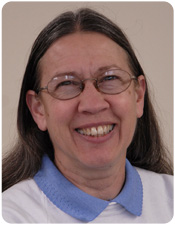Every three years, awards committee members from the South Carolina Entomological Society select an esteemed entomologist to receive the coveted Cochran Award for Excellence. Former Winthrop zoology professor and passionate entomologist Paula Mitchell was selected as this year’s recipient of the decoration for her decades-long contributions and research towards the study of insects.
“I was delighted, it was such a tremendous honor. But, truly, it only happened because of my students,” Mitchell said. “We published a lot in the society’s journal. Whenever my students had enough data to publish, that’s where we’d put it. Over the years, we have had four papers published in the Journal of Agricultural and Urban Entomology, published by the society. I attribute a lot of my achievements to the work I have done with my students.”
Mitchell became a member of the Winthrop faculty in 1993 and primarily taught zoology courses, alongside general education courses in science and other biology-related classes. She joined the S.C. Entomological Society soon after joining Winthrop’s faculty and served on the organization’s executive board for many years. She served as the society’s first female president in 2001, proudly describing the experience as the “only glass ceiling I’ve ever broken.”
Mitchell retired from her position as a professor in 2018 and currently serves as the part-time biology museum collections manager for the university, as well as an adjunct faculty member for Clemson University’s Department of Plant and Environmental Sciences. During her tenure, some of her favorite courses to teach included BIOL 304 (Insect Field Studies) and what is now BIOL 314 (Animal-Plant Interactions), which was previously BIOL 404.
“I actually started off as a herpetologist, which is someone who studies lizards, turtles, snakes, etc,” Mitchell said. “I wanted to know why lizards eat what they do; why they choose certain insects to eat over others. When people studied lizards back then, the way to do lizard ecology was to go out with a gun and shoot the lizard to cut it open and see what its gut contents were. It just wasn’t right for me.”
Noticing her uncertainty, an older colleague of Mitchell’s advised her to decide what interested her more in her studies: the animal she was researching or the scientific question she was trying to answer. One night, the pensive researcher found herself wandering the field station when she happened upon a feeding, unsuspecting stink bug.
“I figured I needed something easier to research and capture than a lizard, as well as something that I could tell what it was eating without killing it. Since then, I’ve been researching stink bugs and other insects ever since,” Mitchell said.
Mitchell considers her most important scientific contribution to entomology to be her utilization and further development of the electrical penetration graph, an entomological method that uses low-level substrate voltage to detect the conductivity of substances within leaves and other plant material. The system enables computers and graphs to pinpoint which substances are being digested by smaller insects that feed through an elongated tube called a proboscis, which doesn’t leave the same definable traces of consumption that the jaws of a caterpillar might. Mitchell’s research, alongside that of her students, focused on expanding the method’s capabilities to enable analysis of larger insects that feed through a proboscis, such as stink bugs and other snout-mouthed critters. By identifying which particular substances a given species of insect digests, scientists and farmers are better able to apply pesticides to specific attributes of the plant to minimize damage to other organisms in the environment.
Despite her significant scientific contributions to entomology, Mitchell considers her greatest achievement in the field to be the positive influence she’s been able to have on students through her instruction.
“It’s being able to convince generations of Winthrop biology majors that there is more to animals than vertebrates; being able to get students interested in insects and worms,” Mitchell said. “If students have any bugs they need to have identified, I’m still here working as the university’s part-time biology museum collections manager.”
Photo courtesy to Winthrop University




